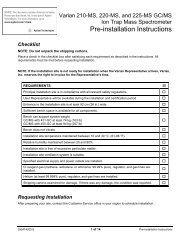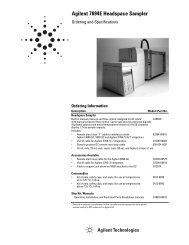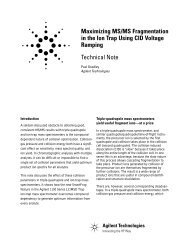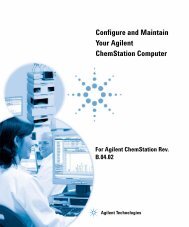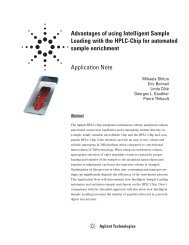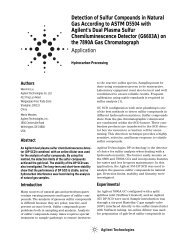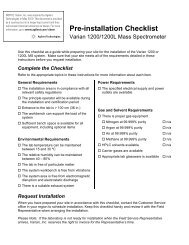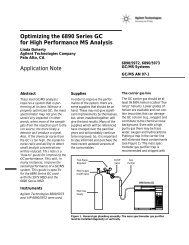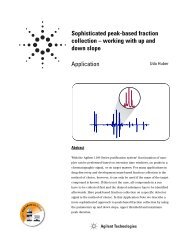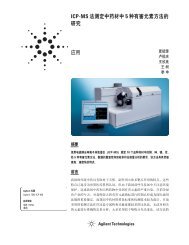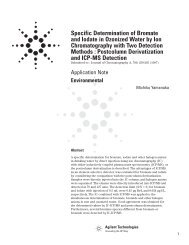598xx Mass Spec will not pump down - Agilent Technologies
598xx Mass Spec will not pump down - Agilent Technologies
598xx Mass Spec will not pump down - Agilent Technologies
You also want an ePaper? Increase the reach of your titles
YUMPU automatically turns print PDFs into web optimized ePapers that Google loves.
<strong>Mass</strong> <strong>Spec</strong> <strong>will</strong> Not Pump Down<br />
Applies to <strong>598xx</strong> series MS<br />
(Excludes 5989A/B MS)<br />
What could be the problem<br />
There are several situations that could cause your <strong>598xx</strong> to have problems <strong>pump</strong>ing<br />
<strong>down</strong>, the following scenarios should help you in isolating problems related to <strong>pump</strong>ing<br />
<strong>down</strong> the <strong>598xx</strong> and establishing a good working vacuum:<br />
• Foreline/Auxillary Pumps<br />
• Neslab (Diffusion Pump Cooling Water Source)<br />
• Diffusion Pump O-Rings<br />
• Manifold O-Ring<br />
• Leak At GC Injection-Port<br />
• Leak At <strong>Mass</strong>-<strong>Spec</strong> Interface<br />
• Broken Column<br />
• Column Flow Too High<br />
This document is believed to be accurate and up-to-date. However, <strong>Agilent</strong> <strong>Technologies</strong>, Inc. can<strong>not</strong> assume responsibility for the use of this material.<br />
The information contained herein is intended for use by informed individuals who can and must determine its fitness for their purpose.<br />
A20347.doc http:// www.chem.agilent.com<br />
http:// www.chem.agilent.com Page 1 of 4
What To Check For<br />
Operation Of Foreline/Auxilary Pumps<br />
Verify the oil level in the sight glass of both foreline and auxiliary <strong>pump</strong>s, and that<br />
there are no oil leaks, then verify operation of the <strong>pump</strong>s. Make sure that both<br />
<strong>pump</strong>s are working. A gurgling noise may be normal, but should <strong>not</strong> continue for<br />
extended periods. If the gurgling sound is prolonged or constant, it can indicate a<br />
leak in the vacuum system. Verify that foreline pressures drop to normal levels<br />
when the foreline <strong>pump</strong> is running. Excessive foreline pressure could indicate a<br />
leak, excessive flow or a <strong>pump</strong> <strong>not</strong> working to capacity.<br />
NESLAB - (diffusion <strong>pump</strong> coolant supply)<br />
Verify that the diffusion <strong>pump</strong> coolant source is operational, providing the correct<br />
flow rate at the proper temperature.<br />
NOTE: It may be difficult or impossible to adequately cool diffusion <strong>pump</strong>ed<br />
systems that are operating on house/facility water supplies that are <strong>not</strong><br />
chilled during the summer months. House water or tap water cooling is<br />
barely marginal in cooling capacity at best and is <strong>not</strong> recommended.<br />
Diffusion Pump Drain/ Fill O-Ring<br />
If your <strong>pump</strong> <strong>down</strong> problems started after shutting <strong>down</strong> the mass spec for<br />
maintenance or column change, (in other words the system was cooled off after<br />
being up and running for a prolonged period of time), then it's possible for the O-<br />
rings on the diffusion <strong>pump</strong> drain/fill spouts are bad. Over a long period of time,<br />
and because of the harsh environment that these O-rings operate in, they <strong>will</strong><br />
become hard and brittle. Typically, they <strong>will</strong> retain their seal until the first time that<br />
the system is cooled <strong>down</strong> and vented. This of course <strong>will</strong> cause the surfaces that<br />
these O-rings seal against to contract, which causes the O-ring, seal to be broken,<br />
and the O-rings <strong>will</strong> <strong>not</strong> be pliable enough to re-seal.<br />
To correct or avoid this problem, replace all four O-rings, two O-rings per diffusion<br />
<strong>pump</strong> on the top and bottom cap of the diffusion <strong>pump</strong> drain/fill spout. These O-<br />
rings <strong>will</strong> be hard and brittle and may be difficult to remove.<br />
A20347.doc http:// www.chem.agilent.com<br />
http:// www.chem.agilent.com Page 2 of 4
Manifold O-Ring/Ceramic Inserts<br />
If any of the vacuum manifold covers or the source was removed and the diffusion<br />
<strong>pump</strong> o-rings have been changed or at least checked, verify that the copper<br />
manifold gaskets are in good shape. Replace these gaskets if they appear to be<br />
worn excessively and make sure that vacuum manifold bolts are torque correctly.<br />
Also if you have been working up around the ceramic standoffs (where the quad<br />
contacts and entrance lens connections are made), make sure that these standoffs<br />
are secure. These standoffs make a vacuum tight seal when pressed into the<br />
manifold and if broken <strong>will</strong> cause an excessive vacuum leak.<br />
Diffusion Pump OverHeat Light On<br />
There is a Diffusion <strong>pump</strong> overheat light on the lower front panel of the <strong>598xx</strong>. If<br />
this light illuminates, it indicates that the one or both diffusion <strong>pump</strong>s have overheated.<br />
A low diffusion <strong>pump</strong> fluid level, chiller problems such as, cooling water<br />
temperature too high or incorrect flow rates, can cause this. It’s also possible that<br />
there may be an electronics problem causing a false error. If the problem can't be<br />
determined to be chiller flow rate or a coolant temperature setting problem, <strong>Agilent</strong><br />
technical support or on-site service is recommended.<br />
Leak at GC Injection Port<br />
After it's determined that the <strong>pump</strong>ing system, (DIFFUSION and FORELINE/<br />
AUXILARY PUMPS), are functioning, then the easiest way to troubleshoot the<br />
system is by eliminating half of the system. In other words remove the column from<br />
the injection port of the GC and cap off (plug) the column by pressing the column<br />
end into a septum.<br />
NOTE: If your column is at least 30 meters long or longer and .25id or smaller,<br />
you should be able to remove the column without venting the system.<br />
However, don't delay in plugging off the column.<br />
Allow the system to continue to <strong>pump</strong> <strong>down</strong> for a reasonable time to establish if<br />
the problem has been corrected. If the problem is corrected by capping off the<br />
column, then we have proved it likely that the <strong>Mass</strong> <strong>Spec</strong> and the column as it's<br />
installed into the <strong>Mass</strong>-<strong>Spec</strong> Interface is OKAY. Troubleshooting can now be<br />
confined to problems at the injection port or column flow rate being too high.<br />
Remember column flow rate should be limited to 1ml/min or less to be able to<br />
establish a good working vacuum.<br />
A20347.doc http:// www.chem.agilent.com<br />
http:// www.chem.agilent.com Page 3 of 4
Leak at <strong>Mass</strong> <strong>Spec</strong> Interface<br />
If the leak persists with the column installed and plugged, you need to use the vent<br />
procedure to vent the <strong>Mass</strong> <strong>Spec</strong> for column removal.<br />
When everything is cooled properly, remove the column from the <strong>Mass</strong> <strong>Spec</strong><br />
interface. Cap off (plug) the <strong>Mass</strong> <strong>Spec</strong> interface by using a blank (no-hone)<br />
ferrule. If you don’t have a blank ferrule, install a short length (< 100mm) of<br />
column into the <strong>Mass</strong> <strong>Spec</strong> interface using a new ferrule and brass interface nut in<br />
just the same way you would install a regular column. Then cap off (plug) the<br />
short length of column by pressing a septum on the end of the column. Pump the<br />
<strong>Mass</strong> <strong>Spec</strong> <strong>down</strong> and allow and appropriate <strong>pump</strong> <strong>down</strong> time to determine if the<br />
problem has been corrected. At this point if the <strong>Mass</strong> <strong>Spec</strong> <strong>pump</strong>s <strong>down</strong> then we<br />
know that the <strong>Mass</strong> <strong>Spec</strong> Interface and <strong>Mass</strong> <strong>Spec</strong> are OKAY. If we are satisfied<br />
that everything is okay, it's time to reinstall the column and make a<strong>not</strong>her attempt<br />
to <strong>pump</strong> <strong>down</strong> the <strong>Mass</strong> <strong>Spec</strong>.<br />
NOTE: You can <strong>pump</strong> the system <strong>down</strong> in stages to verify everything as you go. To do<br />
this, install the column, using a new ferrule, into the <strong>Mass</strong> <strong>Spec</strong> interface and<br />
plug the injection port end of the column just like we did before. If everything<br />
checks out okay, remove the septum plug, from the injection port end of the<br />
column and install column into the GC injection port. Verify if the problem still<br />
exists. Proceed to next step if the problem is <strong>not</strong> corrected.<br />
Broken Or Cracked Column<br />
If there was a problem <strong>pump</strong>ing <strong>down</strong> with the column plugged, then shut system<br />
<strong>down</strong> and check column basket for a possible broken or cracked column.<br />
Column Flow Too High<br />
Remember to always verify the flow rates into your <strong>Mass</strong> <strong>Spec</strong>. Typical flow rates<br />
are between 1 and 2 ml/min. Refer to your hardware manual for the particular flow<br />
rating for your <strong>pump</strong>ing system. Also, using columns with internal diameters of<br />
.32mm or larger could make it difficult to achieve proper vacuum or to set proper<br />
head pressure on the column.<br />
If the problem persists, <strong>Agilent</strong> Technical Support or on-site service is recommended.<br />
A20347.doc http:// www.chem.agilent.com<br />
http:// www.chem.agilent.com Page 4 of 4



